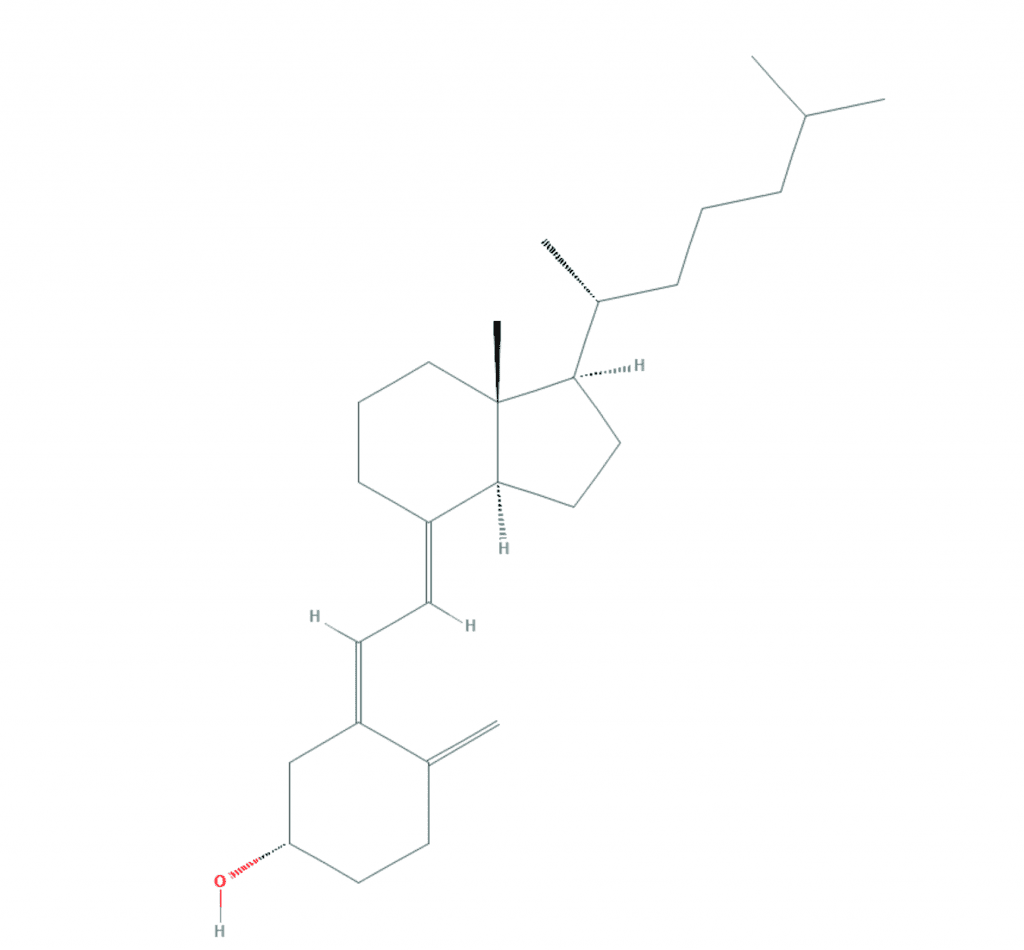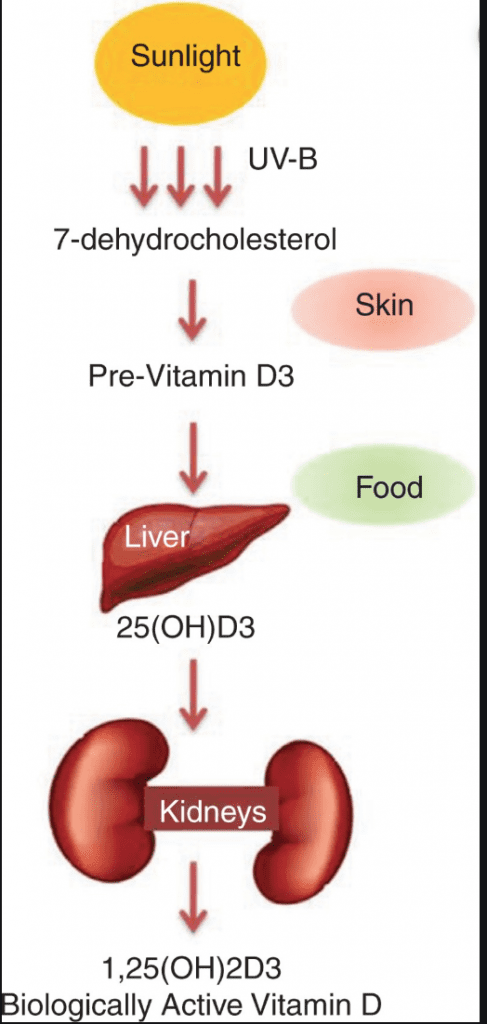By Dr. Sarah Bennett, NMD / January 4, 2020

When you think of Vitamin D, you probably think of sunshine and feeling great! But there is so much more to it that you might not know, especially in terms of how vital it is for your health.
So, where do you begin? What is Vitamin D? Why do so many people talk about how important it is? What could happen if you don’t get enough… and what should you do to make sure you fix that?
Luckily, we have the answers for you right here in this ultimate guide! Without further ado, here is everything you need to know about Vitamin D (plus how we at Natural Med Doc can help make sure you’re getting enough).

The best place to start is at the basics! So, what is Vitamin D in the first place? And how does it impact and interact with your body?
Vitamin D is an essential fat-soluble secosteroid that is naturally synthesized in the body from sun exposure and nutritional intake. A secosteroid is a type of steroid that has a “broken” ring in its chemical makeup (as you can see in the photo above with the seemingly incomplete hexagon).
This subclass of steroids has a similar structure to that of hormonal steroids in the body like androgens or cortisol. Therefore, Vitamin D is often thought of as a “prohormone” (an inactive precursor of a hormone) rather than a vitamin.
Vitamin D is divided into 2 main compounds: Vitamin D3 (cholecalciferol) and Vitamin D2 (ergocalciferol). These are the two most common forms, so they’re really the only ones you will need to worry about in this guide.
Vitamin D2 is produced by plants while Vitamin D3 is produced in animals through UVB conversion in the skin (in other words – this originates in sunlight).
Vitamin D2 and D3 were originally thought to have an identical potency due to going through the same 2-step activation pathway. Recently, studies have shown that during the formation of Vitamin D2, it is deactivated. This causes it to have a relatively lower binding capacity to the Vitamin D receptor.
Vitamin D2 has also been shown to degrade in the body faster than Vitamin D3. Consequently, it is not surprising that treatment efficacy is found to be high when using Vitamin D3, especially for corrective purposes with deficiencies.
Now that we’ve established the overall facts about what Vitamin D is, we can dive into what it does and how it impacts your body. After all, it is one of the most vital parts of a fulfilling and happy life!
Vitamin D is primarily responsible for regulation of calcium, magnesium, and phosphorus in the blood. Plus, it is vital in promoting healthy growth and remodeling of bones!
To go more in depth, some of Vitamin D’s main functions include:
Essentially, if you’ve heard that Vitamin D is one of the most important things to stay on top of, you’ve heard correctly. It can make a massive difference in your mood, energy, health, and overall quality of life!
That said, a lot of the symptoms of both Vitamin D deficiency and toxicity (which will go into now) could always be indicative of other problems or imbalances, so always consult with your naturopathic physician to make sure you are accurately addressing the symptoms you experience!

The most common issue that people will see with Vitamin D is a deficiency or suboptimal levels. This is because without supplementation, it is not only difficult to have too much Vitamin D, but also to even have enough.
Since this is such a common problem, many of the symptoms associated with a deficiency can be seen as normal problems that everyone encounters. Some signs that your Vitamin D levels are too low include:
Severe and chronic Vitamin D deficiency in children will cause Rickets (classified by osteomalacia, improper calcification, softening, and distortion of bones). Vitamin D is usually absorbed well from sunlight, supplementation, and select foods. That said, conditions like celiac disease, irritable bowel syndrome, kidney disease, and cystic fibrosis may inhibit absorption and increase the risk of Rickets.
Concerning symptoms to watch for include:
If you are reading through this and realizing that so many of these points pertain to your life, it may be worth talking with a naturopathic doctor to see if Vitamin D is the root of your problems. It is truly mind boggling how much can be changed by sufficient levels!
We as a society talk a lot about Vitamin D deficiencies… but what about when you have too much Vitamin D? Can there be too much of a good thing?
As it so happens, you absolutely can experience Vitamin D toxicity if your levels are too high. This is far less common than deficiencies since it is incredibly hard to accomplish without supplements, but it still possible and can cause a variety of problems.
As mentioned, Vitamin D toxicity most commonly occurs due to a dosing error with over-the-counter supplements. Toxic levels are seen at serum concentrations of 150 ng/ml and above, generally caused by taking a daily dose of 50,000IU.
Since Vitamin D increases absorption of calcium from the GI tract, toxic levels primarily manifest as elevated serum calcium levels. The symptoms associated with Vitamin D toxicity are primarily associated with a hypercalcemic state and include:
Treatment for Vitamin D toxicity includes discontinuing Vitamin D supplementation and avoidance of dietary calcium, so it isn’t difficult to remedy the situation. Just be sure to talk to your naturopathic physician to make sure this is the root of your problems and can adjust your lifestyle accordingly!

Though Vitamin D is primarily associated with bone health, deficiencies have been associated with an increased risk of many diseases as well. These include autoimmune conditions, cardiovascular disease, cancer, diabetes, hypertension, depression, and COPD.
Osteoporosis is a progressive disease process in which bone density begins to deteriorate and cause fragile, porous bones. This increases the risk of fracture and even mortality. Vitamin D deficiency is strongly associated with the development of osteoporosis due to the decrease in calcium absorption from the GI tract and increase in Parathyroid hormone (PTH). PTH helps to regulate serum calcium levels through bone remodeling and calcium resorption.
Vitamin D deficiency contributes to the development of osteoporosis due to less calcium being absorbed through the intestines, less mineralization of bones, and more PTH being secreted and remodeling/breaking down bone.
Although findings have been inconsistent, the majority of Vitamin D research has found an inverse association between Vitamin D levels and cancer risk. Specifically, the lower your levels are, the higher your risk will be.
Prolonged Vitamin D deficiency can double a person’s risk of developing cancer, especially in the prostate, breast, colon, and blood/bones (leukemia). Vitamin D receptors are found widely throughout the body and help regulate healthy gene expression. In the case of cancer, Vitamin D assists in regulating cellular proliferation, apoptosis (cell death), inflammatory factors, and DNA repair.
Vitamin D has a substantial impact on cardiovascular health. This is likely due to the fact that receptors are found not only in the heart, but throughout the entire cardiovascular system.
Cardiovascular disease resulting in mortality has a strong association with environmental factors leading to Vitamin D deficiency. Vitamin D metabolites have been shown to improve cardiac contractility, slow smooth-muscle cell proliferation, decrease inflammatory cytolines, protect against deep vein thrombosis and embolism, regulate the renin- angiotensin- aldosterone system (RAAS), and even improve the endothelial cell productions of nitric oxide.
Optimal Vitamin D concentrations have been shown to protect against formation of atherosclerosis, inhibiting macrophage cholesterol uptake and decreasing formation of foam cells.
Metabolic syndrome is a set of conditions that occur simultaneously and increase risk of cardiovascular disease and stroke. These conditions include obesity, high blood pressure, elevated cholesterol, and diabetes.
Vitamin D deficiency increases the risk of developing all conditions associated with metabolic syndrome. OBesity has been shown to be inversely related to serum Vitamin D concentrations.
If you are a critical thinker, you may be wondering if this is simply due to a tendency for obese individuals to have less sun exposure and lower outdoor activity time. Well, research has further shown that Vitamin D inhibits adipogenesis (fat formation) and increases thermogenesis (a mechanism to maintain a consistent body weight and burn excess adipose stores.
Vitamin D supplementation in deficient diabetic patients has been shown to decrease hemoglobin A1C values. Vitamin D deficiency is associated with poor production of insulin and decreased pancreatic beta cell survival.
Insulin sensitivity is improved with Vitamin D upregulation in expression of cellular insulin receptors. Vitamin D deficiency contributes to the development of hypertension due to a resulting upregulation of RAAS. Upregulation of RAAS increases aldosterone, a mineralocorticoid hormone that, when produced, increases blood volume.
Healthy Vitamin D concentrations decrease risk of developing not only infections but also autoimmune conditions. Vitamin D receptors have been found throughout the immune system, including in activated T cells and monocytes.
Vitamin D modulates the immune system through decreasing pro-inflammatory cytokines and changing the Th1/Th2 cell ratio to favor the anti-inflammatory Th2 cells. Vitamin D enhances Th2 and Treg cell response and increases production of natural killer cells.
It is important to maintain optimal levels of Vitamin D not only during flu season but throughout the year to help prevent development of more severe autoimmune conditions.
The well-known association between depression and lack of sun exposure was first documented 2,000 years ago. Vitamin D deficiency is associated with an 8-14% increase in depression and a 50% increase in suicidal thoughts and actions. Research shows that the antidepressant effect of Vitamin D supplementation in deficient individuals may be comparable to that of antidepressant medication.
Vitamin D strongly impacts proper neurological development and health, supporting proper dopamine production, norepinephine production, and HPA axis function. Vitamin D deficiency has been suggested to be associated with anxiety and possibly even the development of Parkinson’s.
While supplements are great to boost low Vitamin D levels, it is important to remember the natural sources as well. These can help you design a lifestyle that best incorporates Vitamin D absorption as you go about your regular activities.
A person’s primary source of Vitamin D3 is natural synthesization response to sun exposure – more specifically, UVB exposure. 15-30 minutes of sunlight between 10:00 A.M. and 3:00 P.M. to exposed skin on the arms, legs, and face are recommended, but 2 hours of daily exposure will yield sufficient results.

Unfortunately, nutritional Vitamin D is not found in many locations or high quantities. Nutritionally, Vitamin D may be found in the skin of fatty fish, many UV-exposed mushrooms, beef liver, egg yolks, and Vitamin D fortified foods.
This is why it is so important to make sure you get outside and in the sun as much as possible, even (especially) if you work indoors all day. Take a walk in the sun during your lunch break or in the morning before you start your day! Your body will thank you and it will make an enormous difference.
In addition to the natural sources of Vitamin D that you can find in certain foods or in increased sun exposure, there are also clinical steps that can be taken. This is particularly important for people with significant deficiencies.
Clinical steps to improving Vitamin D are generally pretty simple. Incorporating the lifestyle changes to boost your natural intake will always be the first step, but may doctors will additionally recommend supplementing Vitamin D3 once daily or once weekly.
Generally, 2,000-5,000IU of Vitamin D3 a day is an effective maintenance dose to support optimal levels of Vitamin D. Something important to note is that not all supplements are made equally! Always ask your naturopathic doctor for physician-grade products. If you are looking on your own, a good rule of thumb is that liquid Vitamin D (drops) will absorb more readily than capsules.

This finally brings us to me and how I would go about helping you handle your Vitamin D levels. This is an area that I care deeply about, so I always make sure to test your Vitamin D levels before proceeding with any diagnosis or treatment plan.
Other doctors will not always test Vitamin D due to lack of insurance coverage. To reiterate, I DO. I find that correcting Vitamin D deficiency or even simply suboptimal Vitamin D levels can make a dramatic difference in a person’s quality of life.
I also find that most people have suboptimal levels even if they aren’t overtly deficient. This is why my standards for Vitamin D levels are a lot more audacious than other doctors.
To further emphasize my stress over Vitamin D levels, I don’t find it all too surprising that most people don’t have the levels I think would help them live their best lives. Why? Simply put, we almost all work inside, cutting us off from the most reliable source of Vitamin D during peak daylight hours.
Once we test your Vitamin D levels, correction is really quite simple. After we discuss the amount of time you spend in the sun and your typical diet, I can help you find a quality supplement and appropriate dose.
As mentioned, you must always run the proper tests and talk this all out with a physician to make sure you are getting the appropriate help! Feel free to book a free consultation with me so we can chat about the best path for you and your circumstances.
Hopefully this guide has helped answer some questions you had about Vitamin D and the role it serves in your life! It truly is vital to living a full life and feeling your best, so understanding the basics should really give you a lot to think about!
To recap, the topics we covered today were:
Of course, it’s always possible that you still have questions, so feel free to reach out! I’ll do my best to answer and clarify anything, or even help you get started on the first steps to addressing your Vitamin D needs!
How do you think your newfound knowledge of Vitamin D will help change your life? What questions do you still have? Let us know!